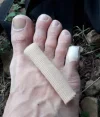cathyke50
New Member
- Time of past OR future Camino
- Camino Frances (St Jean to Belorado; Astorga to Santiago)
Just done 10 days on the Camino Frances in my new hiking shoes (Merrell MQM Flex). I'd worn them for months beforehand, including hiking for four days in the Lake District (UK) - all fine. However, by Day 6 on the Camino, I'd developed a blister on the inside of one heel (under the callous). The rest of both feet were absolutely fine - the problem is around the heel. I assume it didn't show up before because I hadn't walked so many days consecutively, and wasn't carrying the same backpack (6kg on the Camino, incl water).
My question is - do I ditch the shoes? Try thicker socks? Try an insole? Is there a special device that deals with heel problems?!
Many thanks, Camino friends!
My question is - do I ditch the shoes? Try thicker socks? Try an insole? Is there a special device that deals with heel problems?!
Many thanks, Camino friends!
















